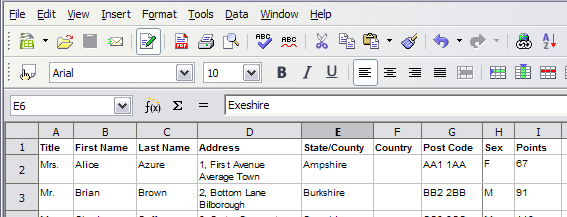Difference between revisions of "Documentation/OOoAuthors User Manual/Writer Guide/Creating the data source"
m (fixed template call) |
|||
| (2 intermediate revisions by one other user not shown) | |||
| Line 1: | Line 1: | ||
| − | {{WriterMailMergeTOC| | + | {{DISPLAYTITLE:Creating the data source}} |
| − | | | + | {{WriterMailMergeTOC|ShowPrevNext=block |
| − | | | + | |PrevPage=Documentation/OOoAuthors User Manual/Writer Guide/Using Mail Merge |
| + | |NextPage=Documentation/OOoAuthors_User_Manual/Writer Guide/Registering a data source }}__notoc__ | ||
= Creating the data source = | = Creating the data source = | ||
| − | Although you can create and print mailing labels and envelopes without using a data source, in most cases using a data source is the most expedient approach. This chapter assumes that you are using a data source. | + | A ''data source'' is a database containing the name and address records (and optionally other information) from which a mailing list may be derived. Although you can create and print mailing labels and envelopes without using a data source, in most cases using a data source is the most expedient approach. This chapter assumes that you are using a data source. |
| − | + | OOo can access a wide variety of data sources, including spreadsheets, text files and databases such as MySQL, Adabas, and ODBC. If the information to be used in the mail merge is currently in a format that OOo cannot access directly, you need to convert it, for example by exporting it to a comma-separated values (CSV) file. | |
| − | For | + | For the following example we use a spreadsheet with the following column (field) headers: ''Title, First name, Last name, Address, State/County, Country, Post Code, Sex, Points''. A sample data source is shown below. |
| − | + | [[Image:WG11-1.png|Spreadsheet data source]]<br>''Spreadsheet data source.'' | |
| − | + | ||
| − | + | ||
| − | + | ||
| − | [[Image:WG11-1.png|Spreadsheet data source]]<br>Spreadsheet data source. | + | |
{{Manual}} | {{Manual}} | ||
Latest revision as of 19:14, 18 September 2009
Creating the data source
A data source is a database containing the name and address records (and optionally other information) from which a mailing list may be derived. Although you can create and print mailing labels and envelopes without using a data source, in most cases using a data source is the most expedient approach. This chapter assumes that you are using a data source.
OOo can access a wide variety of data sources, including spreadsheets, text files and databases such as MySQL, Adabas, and ODBC. If the information to be used in the mail merge is currently in a format that OOo cannot access directly, you need to convert it, for example by exporting it to a comma-separated values (CSV) file.
For the following example we use a spreadsheet with the following column (field) headers: Title, First name, Last name, Address, State/County, Country, Post Code, Sex, Points. A sample data source is shown below.
| Content on this page is licensed under the Creative Common Attribution 3.0 license (CC-BY). |
